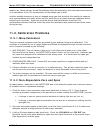
Model GFC7000E Instruction Manual TROUBLESHOOTING & REPAIR PROCEDURES
04584 Rev A1 194
5. If an IZS option is installed in the instrument, press CALZ and CALS. If the flow increases
then suspect a bad sample/cal valve.
11.1.6.3. High Flow
The most common cause of high flow is a leak in the sample flow control assembly or between
there and the pump. If no leaks or loose connections are found in the fittings or the gas line
between the orifice and the pump, rebuild/clean the sample flow control assembly as described in
Section 11.5.1.
11.1.6.4. Displayed Flow = “XXXX”
This warning means that there is inadequate gas flow. There are four conditions that might cause
this:
1. A leak upstream or downstream of the flow sensor
2. A flow obstruction upstream or downstream of the flow sensor
3. Bad Flow Sensor Board
4. Bad pump
To determine which is the case, view the sample pressure and sample flow functions on the front
panel. If the sample pressure is reading abnormally low, then the cause is likely a flow obstruction
upstream of the flow sensor. First, check the sample filter and make sure it is not plugged and
then systematically check all the other components upstream of the orifice to ensure that they are
not obstructed.
If the sample pressure is reading normal but the sample flow is reading low then it is likely that
the pump diaphragm is worn or there is an obstruction downstream of the flow sensor.
11.1.6.5. Actual Flow Does Not Match Displayed Flow
If the actual flow measured does not match the displayed flow, but is within the limits of 720-880
cc/min, adjust the calibration of the flow measurement as described in Section 6.9.8.
11.1.6.6. Sample Pump
The sample pump should start immediately after the front panel power switch is turned ON. With
the Sample Inlet plugged, the test function PRES should read about 10”-Hg for a pump in good
condition. Readings above 15”-Hg indicate that the pump needs rebuilding. If the test function
SAMP FL is greater than 10 cc the instrument’s there is a leak in the pneumatic lines.
11.1.7. Poor or Stopped Flow of Purge Gas
If sufficient purge gas is not supplied to the GFC wheel housing, cyclical fluctuations in readings
at zero or low CO
2
concentrations, such as < 100 ppm, may occur. These fluctuations are the
result of changes in the CO
2
concentration of the ambient atmosphere throughout the course of
the day and night. In isolated areas with relatively few people working nearby the ambient CO
2
concentration will fall during the day and rise during the night as rate of photosynthesis of the
plants in the surrounding area decreases and increases. In a lab environment with a relatively
high human occupancy the ambient CO
2
concentration will increase during those parts of the day
when the highest number of workers are present. If the GFC wheel housing is allowed to fill with


















